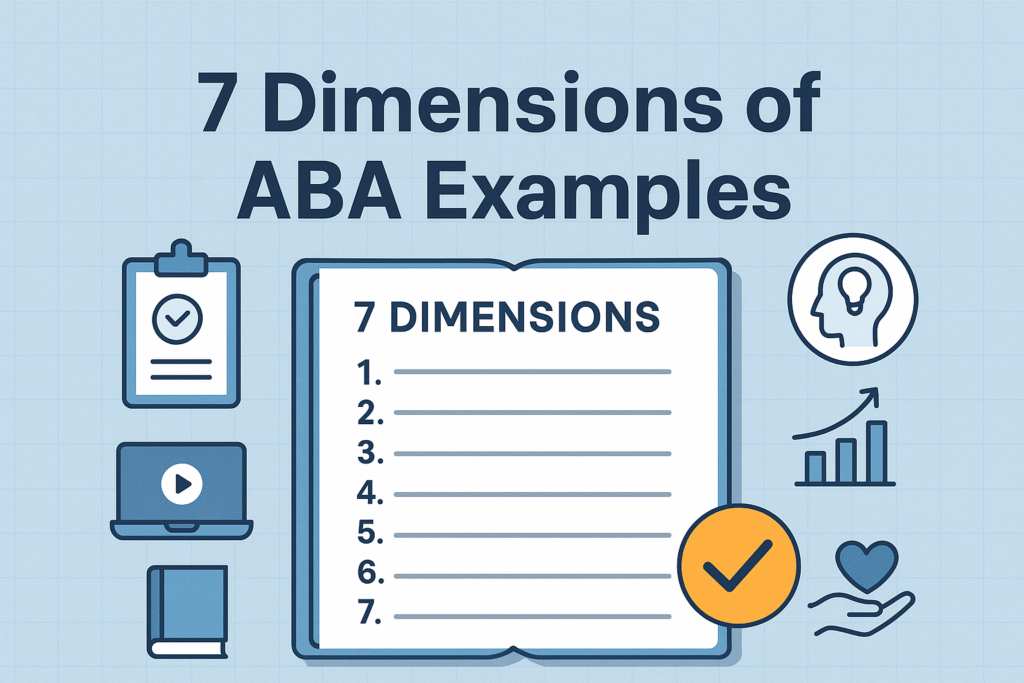Applied Behavior Analysis, or ABA, is one of the most widely recognized approaches for supporting individuals with autism and other developmental challenges. At the heart of ABA are the 7 dimensions of ABA, a framework introduced in 1968 by Baer, Wolf, and Risley. These dimensions ensure that interventions are meaningful, practical, and scientifically grounded. In this guide, we’ll break down the 7 dimensions of ABA with examples you can easily understand and apply, whether you’re preparing for the RBT exam or simply learning about ABA therapy.
Table of Contents

What Are the 7 Dimensions of ABA?
The 7 dimensions of ABA were first outlined in a landmark paper, Some Current Dimensions of Applied Behavior Analysis (Baer, Wolf, & Risley, 1968). They provide a roadmap for ensuring ABA interventions are effective and ethical. Each dimension addresses a different aspect of how behavior analysis should be applied, measured, and evaluated.
These seven dimensions are:
- Applied
- Behavioral
- Analytic
- Technological
- Conceptually Systematic
- Effective
- Generality
Let’s walk through each one with clear examples.
7 Dimensions of ABA Examples (With Practical Scenarios)
1. Applied
This dimension focuses on behaviors that are socially significant and meaningful in everyday life.
Example: A therapist helps a child with autism learn to brush their teeth independently. This skill is applied because it improves daily living and promotes independence.
2. Behavioral
ABA targets observable and measurable behaviors, not thoughts or feelings.
Example: Instead of saying “the child feels anxious,” a therapist measures how often the child avoids eye contact or refuses to participate. Observable actions allow for accurate tracking.
3. Analytic
Analytic means decisions are based on data, not assumptions. Therapists analyze whether interventions are truly causing the behavior change.
Example: If a child increases communication after a new teaching method is introduced, data is collected and compared to baseline performance to confirm effectiveness.
4. Technological
Interventions must be described clearly so that others can replicate them.
Example: Instead of saying “teach communication skills,” the therapist writes a step-by-step plan: use picture cards, prompt with gestures, provide reinforcement, and fade prompts gradually.
5. Conceptually Systematic
Every strategy in ABA should be based on established behavioral principles, such as reinforcement, shaping, or extinction.
Example: A therapist consistently uses positive reinforcement (like praise or tokens) to encourage desired behaviors, ensuring the intervention is rooted in behavioral science rather than guesswork.
6. Effective
The intervention must create meaningful improvements in the individual’s life.
Example: Teaching a child to ask for help reduces frustration and tantrums. The outcome is not just theoretical; it makes daily life easier for both the child and their family.
7. Generality
Behavior change should last over time and occur across different settings, people, and situations.
Example: A child learns to say “hello” during therapy sessions and continues using it at school, at home, and in the community. This shows generalization of the skill.
Why Are the 7 Dimensions of ABA Important for RBTs?
For Registered Behavior Technicians (RBTs), understanding the 7 dimensions is not just theory—it’s practical knowledge required for ethical and effective therapy. The RBT exam often tests knowledge of these dimensions, and real-world practice relies on applying them consistently.
By studying examples of each dimension, RBT candidates can better prepare with an rbt practice test or an rbt mock test. These tools help reinforce not only the definitions but also how to recognize the dimensions in applied settings.
FAQs About the 7 Dimensions of ABA
What are the 7 dimensions of ABA in simple terms?
They are a set of guidelines that make sure ABA therapy is useful, measurable, data-driven, clearly explained, based on science, effective, and long-lasting.
Who created the 7 dimensions of ABA?
They were first described in 1968 by Baer, Wolf, and Risley in the Journal of Applied Behavior Analysis.
How do the 7 dimensions of ABA help in autism therapy?
They ensure interventions focus on meaningful skills, are backed by data, and produce real improvements that last in different environments.
Are the 7 dimensions of ABA on the RBT exam?
Yes, the RBT task list emphasizes knowledge of the 7 dimensions. Practicing with an rbt practice exam can help you prepare.
Conclusion
The 7 dimensions of ABA examples show how therapy can be practical, effective, and life-changing. From teaching independence to ensuring skills generalize across settings, these dimensions are the foundation of applied behavior analysis.
If you’re preparing for the RBT exam, mastering these concepts is essential. Strengthen your knowledge today by starting an rbt practice exam and build the confidence you need for success.
